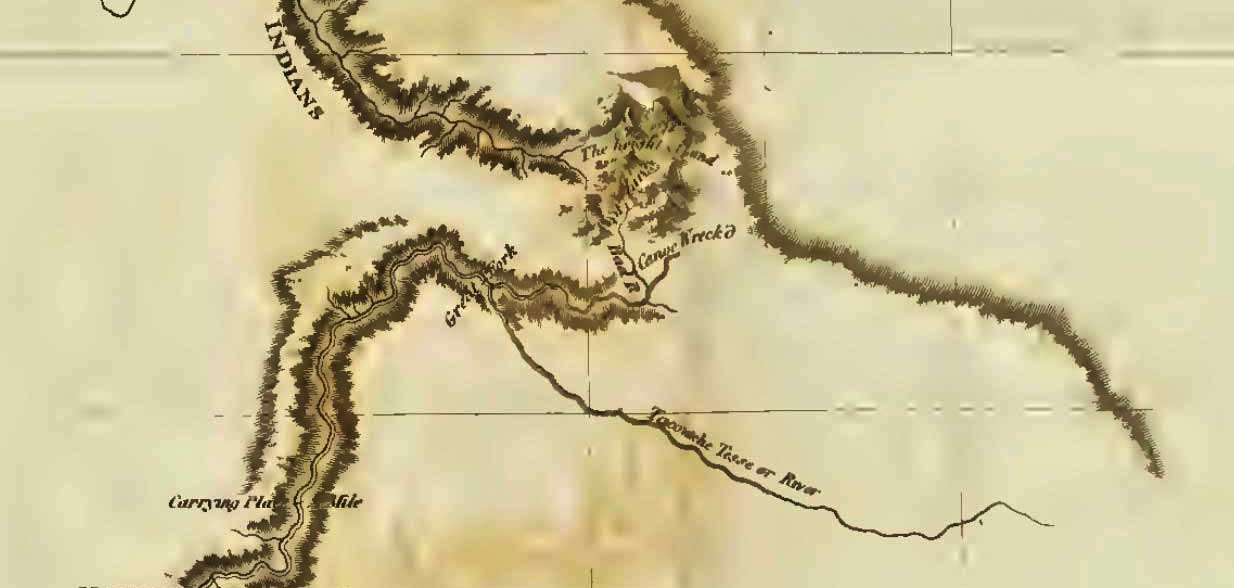North arm of Kinbasket Lake
52.5 N 118.8 W — Map 83D/10 — Google — GeoHack
Name officially adopted in 1973
Official in BC – Canada
This was Canoe River before flooding of Kinbasket Lake behind Mica Dam.
This was Canoe River before flooding of Kinbasket Lake behind Mica Dam.
Arthur Oliver Wheeler [1860–1945] suggested the name “Poodle Peak” because the summit resembled in shape the head of a poodle. The French word for poodle was chosen “to further distinguish the name,” according to the Akriggs, who do not specfiy their source. Wheeler explored in the Mount Robson area in 1911 and 1913, and was involved in naming places during the Alberta-British Columbia Boundary Commission surveys, 1917–1923.

Map of Mackenzie’s track in 1793 (detail of pass through Rocky Mountains)
Internet Archive
Alexander Mackenzie [1764–1820] travelled from his winter quarters near Finlay Forks to the Pacific coast in 1793. On his return, travelling through the same unnamed pass through the Rocky Mountains that he traversed on his voyage out, he wrote in his journal:
Friday, 16 August, 1793. The weather continued to be the same as yesterday, and at two in the afternoon we came to the carrying-place which leads to the first small lake; but it was so filled with drift wood, that a considerable portion of time was employed in making our way through it. We now reached the high land which separates the source of the Tacoutche Tesse, or Columbia River, and Unjigah, or Peace River: the latter of which, after receiving many tributary streams, passes through the great Slave Lake, and disembogues itself in the Frozen Ocean, in latitude 69-1/2 North, longitude 135. West from Greenwich; while the former, confined by the immense mountains that run nearly parallel with the Pacific Ocean, and keep it in a Southern course, empties itself in 46. 20. North latitude and longitude 124. West from Greenwich.
Mackenzie was incorrect about Tacoutche Tesse being the Columbia River, it is the Fraser River.
The name “James Creek” was adopted in the 18th Report of the Geographic Board of Canada, 1924, not “Bad River”, the long-established local name. The name was changed to “Bad River (James Creek)” in 1976 to accommodate local usage, which dates to the earliest days of exploration in the northern Rocky Mountains.
On the alpine slopes of this mountain grow the pink-flowered (or is it blue?) moss campion, a circumpolar, mat-forming alpine plant of the genus Silene.
“Still higher up were several kinds of flowering mosses: the pink (moss campion), the white, and the yellow,” wrote explorer Arthur Oliver Wheeler [1860–1945] in 1912.
Possibly named by the Alberta-British Columbia Boundary Commission, of which Wheeler was a member, in 1922.
The flowering plants bladder campion and alpine campion are indigenous to the Canadian Rockies.
This creek has also been labelled variously “Wall,” “Wallpass,” and “Treadmill” creek.
The camp was that of Canadian Pacific Railway surveyor Roderick M. McLennan [1805–1908] whose party wintered here in 1871–72.
Not associated with the famous Boat Encampment of David Thompson [1770–1857] (also known as Canoe Encampment).